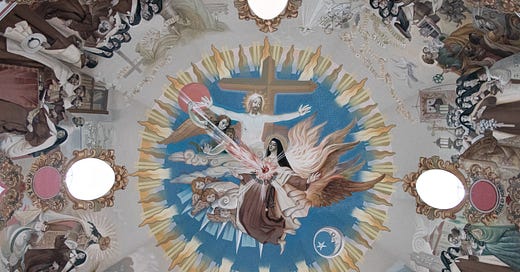(Source: Hugo Gonzalez, The Transverberation of Teresa of Jesus, Templo Conventual de Nuestra Señora del Carmen, via Cathopic)
Madre Teresa was fifty-two years old when she met twenty-five year old Fray Juan de Yepes, a Carmelite novice at Salamanca. She needed reliable confessors for her nuns in the reformed monasteries.
Given the facts, likely Juan was caught off-guard by Teresa’s style. Sunny, personable and determined, Teresa seemed to be his opposite. Inexperienced, artistic and deeply ascetic, Juan yearned to unite his simple joy in creation with the poverty of Christ. Teresa recognized his sanctity, noting in her journal that she could learn more from him than he could learn from her.
They were a study in contrasts. Juan’s family joined an “army” of beggars created by a severe food shortage in Castile. (A locust scourge in 1542, followed by years of meager harvests and disease decimated the already impoverished families of the region.) His father died when he was a toddler. His mother moved three times in five years. Successful begging was the special Yepes family charism. Little Juan often begged for those unable to do so. Thus, he and his elder brother Francisco were known for charity!
Wealth and honor belonged to Teresa’s family, but they were not without suffering. Teresa’s mother died at thirty-three after bearing nine babies, leaving teen-aged Teresa with a negative attitude toward the physical hardships of marriage. Pretty and vain, Teresa nonetheless fell in with a merry group of boy-crazy cousins, irritating her grieving father.
He sent her to boarding school to break up the group, where she discovered some of the joys of religious life. Her father was shocked when his favorite daughter entered the Convent of the Incarnation in 1536. Teresa fell ill, perhaps from malaria, and spent most of her novitiate recuperating, nearly dying in 1539.
Even after her father died in 1543, she loved the less-than-sacred elements of life at Incarnation. Many of the nuns didn’t belong in a convent at all, and carried on with visitors in scandalous ways. Teresa was one of the more virtuous, comparatively speaking. She had a special way of reaching out to souls, and once she dedicated this faculty to the Lord alone, her path to sanctity was steady.
Thus, in 1567, Juan confided a deep secret to Teresa: he was having vocational doubts, inclined to leave Carmel for the Carthusians. Teresa deftly reminded him of the depth of his devotion to Our Lady of Mount Carmel. With the sureness of purpose that marked all of her work, she believed the Lord sent Fray Juan to her. Eventually, he decided to wait while she made the arrangements to form the first monastery of reformed Carmelite friars.
The first monastery at Duruelo was a dilapidated farmhouse, barely better than a pigsty. On his journey as the first friar of the discalced Carmelites, Fray Juan carried a habit tailored by Madre Teresa, and walked barefoot as the friars were “discalced,” or shoeless. (Teresa prudently forbade the “discalced” friars to walk barefoot in the winter.) Fray Juan reveled in two months of solitude, setting up the monastery prior to the arrival of three more brothers in November 1568. His joy was palpable.
During Advent, la Madre managed to visit her pet project. She was mildly disturbed by the profusion of crosses and skulls adorning the little “Stable of Bethlehem.” While meant to remind holy souls of the last things, the mother’s heart in Teresa was stirred. While she approved of their prayerful lifestyle, she “begged them not to be so rigorous in penitential practices.” At the same time, their obvious joy in the new foundation was contagious, and she “went away greatly consoled.”
The gifts of the Lord for the two friends went both ways. Madre Teresa helped Juan to find his place among the Carmelite friars, renaming him Fray Juan de la Cruz. Years later, Fray Juan would repay her amply by providing spiritual direction to her and the nuns at the Incarnation, when Teresa was prioress from 1572-1575.
Motherhood cuts both ways. It brings with it deep responsibilities, but also sublime self-knowledge and above all, the joy of sharing love. May your motherly relationships be a source of resurrection for you!





